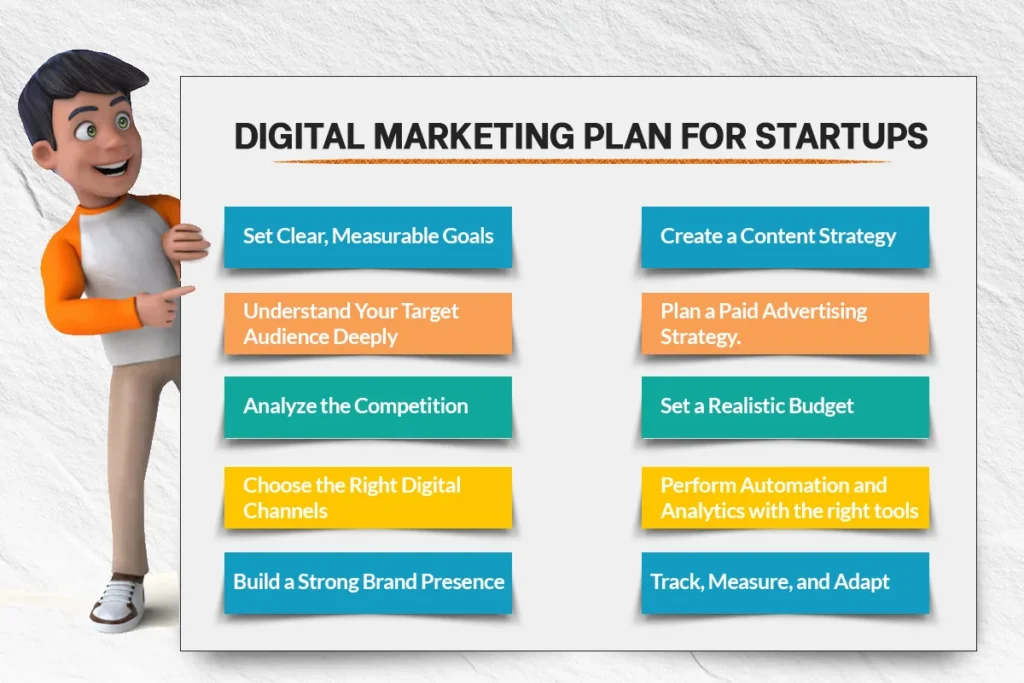
Having a game changer digital marketing plan is a great boost for any startup wishing to leave a mark in a busy market. Breaking down a step by step approach to setting goals, finding audiences, picking the right channels, allocating a budget, and measuring results, they guide startups in creating a strong, scalable, digital presence from the beginning. For startups, the right plan in place allows for maximizing the resources and accelerating their growth.
Introduction
The Unique Challenge for Startups:
It is exhilarating starting a business, but the journey of most startups are full of challenges. With limited budget, tight deadlines, and cut throat competition, it is tough to compete with established players. However, with a good push in a digital marketing strategy plan for startups, a small business can make a big impact and grow its brand.
Why is a Perfect Digital Marketing Plan crucial if you are early on?
Having an early startup marketing strategy makes sure that you are not wasting money on multiple tactics and hoping for something to stick. Rather than that, it lays down a strategic path which is going to enable you to grow the audience, create leads, and win the trust from future customers. Having a plan that lines up with your business goals and the special aspects of your target market will allow you to build marketing that is sustainable.
What This Guide Will Cover:
In this blog let us see how to create a beginner Digital Marketing Plan for your startup. Regardless of whether you are new to the game or have stuck to the same approach till now, this guide aims at providing actionable steps in creating a digital marketing strategy without excessive wastage of resources.
Digital Marketing Plan for Startups

Set Clear, Measurable Goals
But, before jumping into the digital world, you should know what success is and regard it as for your startup. What are you trying to do? Build brand awareness, generate leads, increase sales, etc. When there are no clear goals, it becomes hard to track progress and know what actually works.
SMART Goals are goals that follow the SMART goal framework (Specific, Measurable, Achievable, Relevant and Time‑bound) that startups use to set clear and actionable goals. For example, don’t say, ‘Increase traffic’ – say something like, ‘Increase website traffic by 30% in the next 3 months by implementing SEO and social media’.
Depending on what business model you have, your goals will focus on building email list, increasing social media followings, driving eCommerce sales etc. At least your goals should be aligned with what will push the needle for your startup.
Understand Your Target Audience Deeply
The basics of any great startup marketing strategy is to simply understand who is your customer and who needs what. Many of the startups that I have spoken with make the same mistake – assuming that they understand their audience, only to find that they have grossly misidentified pain points down the line.
Develop Buyer Personas: Develop in depth buyer personas for each persona with demographic information, behaviors, needs and challenges. It’s helpful for you to create your content and messaging according to your audience’s expectations.
Research and Feedback: Surveys, social media penetration, and feedback from current customers will aid in understanding. Understanding your audience lets you get your message across while selecting the ideal medium to strike it.
Analyze the Competition
Further, in a digital age, the understanding of one’s competition is as important as the understanding of one’s customer. Knowing what to do and what not to do is also possible through analyzing what your competitors are doing online.
Competitive Digital Marketing Audit evaluates your competitors’ marketing tactics. Do they use social media actively? Do they have a blog? Are they running paid ads? Which platforms are they investing in?
Understand your weaknesses so that you can use them to outperform them by identifying gaps and opportunities. For example, in case your competitors are not utilizing video marketing, this might be one particular aspect of the place your startup will be distinctive.
Choose the Right Digital Channels
You have lots of space to play on with digital channels, but not all of them might be relevant for your startup. Therefore, you face the need to concentrate your efforts on the main platforms for the audience that you target.
If your target demo is younger and socially savvy, then Instagram or TikTok might work out better for you. LinkedIn is a great option for B2B brands. If you are working in the industry with high search intent, SEO would be a matter of priority.
Channel Diversification: You can never be too cautious to experiment with different channels but you should be cautious as to not go overboard. The first thing you would want to do is to concentrate your efforts on 2–3 platforms and grow later once you start getting results from these.
Build a Strong Brand Presence
An important thing for the startup is to build the familiar brand. Having a strong digital presence will make your audience trust you more and that builds credibility.
Maintain consistency across platforms: your brand voice, logo, messaging should be consistent no matter what platform or website. The benefit to this consistency is that it increases recognition, your positioning in the marketplace.
Create a Memorable First Impression: Potential customers may or may not even contact you directly, but your website and social media profiles are often the first introductory shenanigans they have with your brand. So make sure that they directly align to your mission, values, and product offerings.
Create a Content Strategy
The heart of digital marketing is and always will be content, and if a startup doesn’t commit to high quality, engaging content, offering value to the readers, that startup may as well pack its bags.
Tutoring: Choose from blogs, videos, podcasts or infographics that solve your audience’s pain points or answer basic questions. A well crafted content will establish you as an authority in your niche.
Content Distribution: Distribute the content on the right platforms and optimise it for search engines (SEO) to make it reach a wider audience. Good content has the power to bring traffic, leads, and long term customer loyalty.
Plan a Paid Advertising Strategy

A small, targeted ad campaign is a great way to get your startup going if you have the budget for it, and likewise early on.
Begin Low with Paid Ads on Social Media or Google: You can easily launch campaigns on Google Ads, Facebook, and LinkedIn that can be highly targeted. Start small to see if you test different creatives of your ad, copy of your ad, and your audiences.
Paid Ads Goals: To begin with, start with directing the ads towards lead generation or brand awareness, and then scale up the campaign as you witness the data that you can measure.
Set a Realistic Budget
Budgeting is key for startups because overspending is an easy mistake to make with the wrong marketing tactics. Additionally, you need to be ready to use these funds across many channels and adjust based on this data.
For a lean startup, much of your budget should be dedicated to SEO and content marketing. Set aside a portion for paid ads and social media campaigns.
Things to keep in mind while facing a content marketing budget problem is experiment and adjusting. Today what may work at some point may need slightly changed tomorrow. An option is to set aside some money for quick pivots and optimizations.
Perform Automation and Analytics with the right tools
An excellent digital marketing plan for beginners needs the appropriate tools for automation and analytics. However, such tools can save you time and make decisions based on data.
Tools for automation: Email marketing, social media scheduling, customer relationship management (CRM).
Finalizing Tools for Analytics: Use platforms like Google Analytics, Facebook Insights, and other analytics tools to measure your digital performance and make sure you are on track.
Track, Measure, and Adapt
Dynamic digital marketing plans are the most effective. Reviewing your performance on a regular basis helps you to refine your strategy.
Establish KPIs: View KPIs for each campaign (traffic, leads, conversion rate). They will act as benchmarks as to how well you are progressing.
Adapt: Modify strategy based on your analytics insight. Small changes have an effect and are accumulated over time – even though they are small, they can lead to great results.
Conclusion
Lastly, digital marketing is crucial for startups’ success. With all the changes it can seem really overwhelming to begin with, but you don’t have to do it all at once. In a work of art, focus needs to be placed on beginning small, but beginning smart. A well structured startup marketing strategy will help your efforts, allocate your budget and make your brand ready for long term growth.
Given so, the best marketing plan is one that’s actionable, flexible and focused around the needs of the customer. It’s time to start crafting a strategy that will work for your specific startup and put you in a good position!
FAQs
Q1. How early should a startup create a digital marketing plan?
Ideally, a digital marketing plan for startups should be created before launch – or as early as possible – to build brand awareness and momentum from day one.
Q2. What’s the best marketing channel for startups on a low budget?
For startups on a low budget, organic content marketing (blogs, SEO, social media) is a cost-effective strategy. If possible, run small-scale paid ads to amplify your efforts.
Q3. How much budget should a startup allocate to digital marketing?
Generally, startups should allocate 5%-12% of expected revenue for digital marketing, depending on the stage of growth and competitiveness of the industry.
Q4. Should a startup hire an agency or build an in-house marketing team?
Early-stage startups often start with freelancers or agencies for flexibility, transitioning to an in-house team as they scale.
Q5. How often should a startup review its digital marketing strategy?
Review your beginner digital marketing plan at least quarterly to stay agile and adjust to changing market trends and customer behavior.






